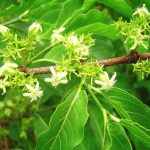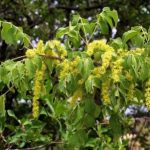TREE LIFE
September 1983
MASHONALAND CALENDAR
Tuesday September 6th : Botanic Garden Walk. Meet in the car park at 1645 for 1700 hours.
Sunday September 18th : Riverine vegetation below the Mazowe Dam wall, et.al. We had done a recce to the area and look forward to a very rewarding day. Huge Celtis, Bequaertiodendron, Rauvolfia etc. etc. Acokanthera was in flower. All in all, lots to see. Lovely birding spot too. We hope to lunch at Triandra Farm, the home of Allan and Helen Foot and then have a look at a couple of interesting things on the farm in the afternoon. A bus has been booked and will leave Monomotapa Car Park at 0900; hours. Fare $5.00.
BOTANIC GARDEN WALK 6TH AUGUST 1983
Our August walk was really exciting as we looked at the indigenous non-dicotyledon trees. Why exciting? Because our first year Botany students are simplistically taught that only dicotyledons, the flowering plants with net-veined leaves, and gymnosperms, the conifers, have a stem designed to grow thicker and thus can form a tree. In these plants a special ring of tissue occurs underneath the bark, that can produce new wood year after year. Monocotyledons, flowering plants with parallel veined leaves, lack this ring so although they are an enormous group including hundreds of grasses and bulbs, their basic stem anatomy limits their size and generally we are taught that “no secondary thickening occurs”. The few monocots. That do form trees are therefore exciting as they get around the same problem in a variety of ways.
We first examined the indigenous palms, family ARECACEAE ex PALMAE. Many palms store up sugar or starch in the stem in preparation for a great terminal inflorescence, often terminal in both senses of the word. The sago is the sap in the stems of the sago palm which is collected at the time it rises up to the developing inflorescence.
The Borassus palm, B. aethiopum, that Tom showed us was 10 years old but was still only a crown of leaves emerging from the grass. This slow growing trunk is one way of overcoming the problem – the palm grows a trunk of the required thickness so in fact “no secondary thickening occurs”. Borassus is difficult to grow, after germination the seed send out a long extension tube which will search out a suitable site for the adult palm, at which point it will develop the new shoot and root, all the time feeding from the seed via this strange umbilical tube. This process takes time, which we learned looking at the vacant spot where a ceremonial planting of an already germinated seed took place 18 months ago. Borassus is the rarest of the indigenous palms, growing in semi rocky outcrops of the Chibi district and the Rusitu Valley. Tom joked about their seductive stems, all of 24/36/24 – a strange swelling that develops in mature specimens and may be related to food storage. In Mozambique where these can be confused with the Ilala palm the distinctive feature is the edible Borassus fruit which is much larger – almost grapefruit size with a fruity smell.
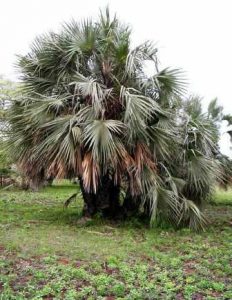
Hyphaene natalensis. Photo: Colin Wenham. Source: Flora of Zimbabwe
Ilala palms, Hyphaene, have a special magic and even Tom’s juveniles bring back memories of nights spent admiring the full moon through the ilala palms of the Sabi Valley. Although they occur along all large low altitude rivers, there are two species, H. natalensis in the south, with a pear shaped fruit, and H. ventricosa, ex benguellensis, with rounder fruit in the north. The seeds, which provide vegetable ivory, can take a year to germinate. The sap is often tapped for making a pleasant palm wine or a more toxic spirit. Tom suspects that a different variety may emerge from examining the specimens in the Sapi river mouth area in the Zambezi Valley.
In contrast to Borassus and Hyphaene which both have fan shaped leaves, the other two indigenous species, Raphia farinifera and Phoenix reclinata are pinnate. Raphia was discussed extensively in Phil’s article last month so I will refrain from further elaboration. The wild date, Phoenix reclinata, is a cluster palm with a wide altitudinal distribution from the dyke to the Rusitu and into Mozambique. Much confusion can arise as the male palms can appear to be a different species to the female which has a shorter flowering shaft. Although the thickness of many palms is due to primary growth alone, in some, simple enlargement of all the existing cells and intercellular spaces can occur. A few palm trunks can undergo cell division after the first year particularly of the sheathing fibers surrounding veins, vascular bundles. The timber is called porcupine wood as the dark bundles for streaks through the light wood.
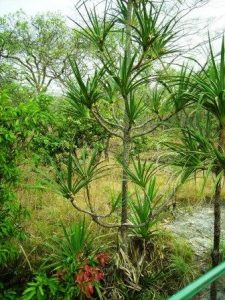
Screw pine, Pandanus livingstonianus. Photo: Mike Bingham. Flora of Zambia
The PANDANACEAE is an interesting family right at the beginning of the monocotyledoneae, next to the bulrush family, TYPHACEAE. It therefore deserves mention although the screw pine, Pandanus livingstonianus, occurs 2 km outside Zimbabwe alongside the first stream on the Mozambique road via the Musapa Gap. We noticed the spiraling leaf scars, hence the common name, and long strap like leaves with thorns along the margins and central midrib. An interesting plant that can reach 10 m with long aerial roots and a cone like fruit something like a “delicious monster”.
Just to prove that secondary thickening can occur in the monocots, the famous dragon tree of Teneriffe, Dracaena draco, which was blown down in 1869 was 70 ft high, 45 ft in girth and was thought to be 6 000 years old. Dracaena belongs to the AGAVACEAE which is part of the order Liliiflorae, together with the LILIACEAE. Some members of the Liliiflorae do have secondary thickening but instead of being laid down as rings of wood, xylem, with a circle of phloem vessels, food transporting tubes, beneath the bark as in the dicots, radiating lines of individual vascular bundles are laid down. As a result ring barking would never succeed in these plants due to the disorganized design, nor is the timber of any value. We examined three indigenous dragon trees : D. fragrans occurs as a forest shrub, common at Mt. Selinda between 1000 – 1800 m. This attractive shrub with bright orange fruit is used worldwide as a pot plant. The large leaved D. steudneri is common on the screes of dry rain forests in the eastern districts, especially on boulders among Crabia and Ficus spp. One specimen can be fairly extensive, up to 100 trunks, each up to 12 m in height. In the understory of gully forests around Mt. Selinda low altitude, below 1000 m, D. reflexa var. nitens grows. Somewhat bushier than the rest it can grow to a height of 10 m. The orange to red fruits don’t taste very pleasant but are easy to grow.
The other family in the Liliiflorae that can undergo this strange thickening is LILIACEAE represented by the aloes. We looked at the bush Aloe arborescens of the high rainfall forest edge Phillipia belt in the eastern highlands, but widely cultivated throughout Zimbabwe. Another eastern districts aloe, A. sessiliflora grows in the Birchenough/Chipinge area. We saw the tight spike of sessile yellow flowers. Nearby in the quartzite hills of the Chimanimani area A. munchii can grow to 5 m. We are familiar with the closely related A. excelsa that we see fairly frequently on our outings. The fifth indigenous tree aloe we did not see, but A. littoralis occurs in lower altitude mopane veld.
Two monocot. families cheat on the poorly designed stem and produce trees by rolling up the leaf stalks to form a false stem, often growing to an impressive height. The first family, MUSACEAE, of which we saw the wild banana, Ensete ventricosum, cannot cheat for long and after 3 or 4 years of vigorous growth and extensive fruiting the plant dies and collapses. We were impressed to see how closely the fruit resembled a banana, although inside the flesh is almost non-existent, being replaced by marble sized seeds all stuck together. On a recent trip to the Honde valley some of us were fortunate to see Ensete growing alongside a mountain stream.
In contrast to the MUSACEAE where the leaves radiate in all directions, the leaves of the STRELITZIACEAE are arranged in two rows. Strelitzia nicolai has white crane flowers and grows along the forest edge on rocky slopes in the Vumba where the soil is too shallow for other trees. It also occurs in Natal dune forests, a strange altitudinal range shared by a number of plants including the yellow daisy Chrysanthemoides monilifera which we passed later.
With the exception of the grasses, POACEAE, this has been a complete coverage of all indigenous monocot trees. We also looked at all indigenous gymnosperms, except for the one local cycad. In the light of secondary thickening it is interesting to note that although we conventionally put them before the monocots., due to their simpler sex life, they do have the advanced secondary thickening found in the dicotyledons. The first of the three gymnosperms we examined was the juniper, Juniperus procera of the CUPRESSACEAE. Although common in Malawi and Kenya, only a solitary tree is known to occur naturally in Zimbabwe, on a hill near the Zewa ruins in the east. The specimen in the gardens was grown from seed collected by Prof Wild from this tree. Unlike other cypresses the cones are fleshy and berry like, probably dispersed by birds. The mountain cedar, Widdringtonia nodiflora is also one of the CUPRESSACEAE. This tree, common in the dry forests in the eastern highlands has interesting needle like juvenile leaves and scale like adult leaves. The only yellow wood, PODOCARPACEAE, in Zimbabwe is Podocarpus latifolius with long tough dark green leaves. The fruits fail to resemble cones, instead the female “cone” forms a bright red fleshy fruit. Yet another eastern highlands plant where it can grow to 40 m in deep soil at 1500 m but is often stunted at high latitudes.
A thorough coverage of many families and a rewarding morning, thanks to our host Mr. Tom Muller.
We then examined the exotic palms around the herbarium and even saw a genuine Dracena draco.
-Kim St.J. Damstra
OUTING TO IVORDALE FARM, ENTERPRISE, SUNDAY 21ST AUGUST 1983
This month our outing was to the Granite Kopjes on Ivordale Farm, Enterprise, at the invitation of the manager, Trevor Cox.
In the morning the bus took members to a farm gate at the foot of a largely bare granite dwala. We had a short walk from the gate to the kopje but on the way we noted Vernonia subuligera in full bloom with pale mauve flowers under Parinari. Also most impressive in bright orange/red colours was a fair sized Pseudolachnostylis maprouneifolia.
At the base of the kopje were a couple of Euphorbia matabelensis, the stems and branches of which showed the typical zig zag growth form. This is one Euphorbia which looks more tree like than cactus like, but if the tree is injured it weeps copious tears of white latex to show it is indeed an Euphorbia. From this point one half of our party headed for the top of the kopje. I was with the less energetic group which skirted round the bottom of the kopje. However, I am sure that both parties were equally impressed by the numbers and size of the Sterculia quinqueloba, many of which carried the characteristic pods and ‘brown tick’ seeds. Because of the pink peeling bark and absence of leaves there was confusion as to whether some specimens might have been Albizia tanganyicensis, but with the lack of other corroborating features I failed to tick this on my field card. Also in the same habitat were truly magnificent specimens of Kirkia acuminata, most of which bore seed capsules and some of which still had a few red autumn leaves, whereas others were flushing new red growth.
We then came across Combretum apiculatum. We were shown the opposite leaves and the pointed tip to the leaf often slightly twisted to one side. Nearby was Zanha africana and new members were shown the terminal bud resembling a “ball and claw”. Just below the granite on level ground was an exceptionally large Heteropyxis dehniae in flower. The leaves of this when crushed are refreshingly sweetly perfumed and compete for top honours in the regard with Croton gratissimus of which we saw several fine examples behind Trevor’s house in the afternoon.
Also on the flat ground at the foot of the dwala we were excited to see a Strychnos innocua with several golf ball sized immature green fruit and a single tennis ball sized mature fruit which was a bright pinkish-orange colour. Meg Coates Palgrave showed us how the bark rubbed off as a powdery grey dust. Apparently this does not happen with S. madagascariensis which it otherwise closely resembles. It was certainly a day for Strychnos as we saw many S. spinosa fruiting heavily with the larger grape fruit sized fruit. But in addition and this was the day’s highlight, we saw a group of enormous S. potatorum on the exfoliated scree a little higher up the kopje. Often we see this as a straggly bushy tree in riverine areas, but I think it is rare indeed to see it as a large trunked free standing tree, as this was, perhaps 10 – 15 m in height.
Standing cheek by jowl with S. potatorum was a tall Cassine matabelica. This had a markedly toothed leaf margin. The leaves were leathery and glossy, dark green above and paler below. In contrast we also saw, in the afternoon, C. transvaalensis, we did not really know until it was confirmed later at the Herbarium. This was a mystery tree, as the leaf margins showed no teeth at all. Generally the leaves were much smaller than C. matabelica and a paler yellow green in colour. Also the leaves tended to come out in fascicles in contrast to C. matabelica which characteristically has alternate and opposite leaves on the same shoot. This was obviously a mature tree, but nearby was a juvenile C. transvaalensis with lanceolate leaves which had markedly toothed margins.
Alongside the morning’s C. matabelica was Tricalysia angolensis which showed off its tendency to remain in flower bud throughout the winter.
On the kopje we saw Ficus glumosa, the small leaved rock fig. This was the first of a number of figs seen during the day – F. natalensis with the ‘truncated tip’ to the leaf, F. sur, ex capensis, F. sycomorus, F. thonningii, ex burkei and on the kopje behind the house a respectable F. salicifolia.
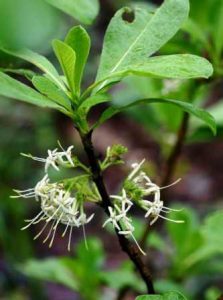
Pavetta schumanniana. Photo: Bart Wursten. Source: Flora of Zimbabwe
Also at the foot of the dwala we saw Afzelia quanzensis, large Pterocarpus angolensis, Pericopsis angolensis and Stereospermum kunthianum. We then found a small Canthium huillense and just to compare, later in the day, a C. lactescens. Nearby we saw Pavetta schumanniana, while I gather the “mountain goats” saw P. gardeniifolia.
On a low flat dwala nearby we came across Elephantorrhiza goetzei just coming into flower buds which were in short pink spikes. Also large Rhoicissus revoilii, Ximenia caffra and a leafless Cassia abbreviata with the beginnings of the lemon yellow flowers, but still festooned with the remains of the long black pods.
Heading back we passed Rhus leptodictya, the mountain Rhus. At first sight this looks a bit like R. lancea, but it has wider and shorter leaflets. These were also turning a pinkish red, which those on R. lancea do not. The habitat, of course, is also quite distinctive.
We went back to lunch on Trevor’s front lawn under some enormous Acrocarpus, Kenya coffee shade trees. These were flowering profusely and many different birds were enjoying the nectar.
After lunch we looked at the kopje behind the house. Some of our finds have already been mentioned but others worthy of note were a large Azanza garckeana in fruit, Euclea natalensis in full flower, Boscia salicifolia next to the Cassine transvaalensis and Pappea capensis. The small specimens of the latter surprised us by appearing in red autumn colours. An interesting find was Maerua triphylla, the small bead bean. Unlike M. angolensis the common bead bean, this is a trifoliate tree. The interesting feature of this specimen was the distinctly purple veins which were prominent on the under surface of the leaf.
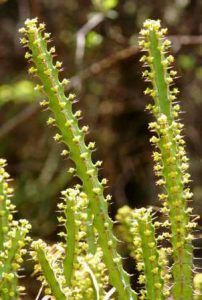
Euphorbia griseola flowers. Photo: Bart Wursten. Source: Flora of Zimbabwe
Near the top of the kopje were a large colony of Euphorbia griseola which were mature trees. More than one member complained that they had pricked their hands trying to use the trunks as hand holds while climbing about.
A very pleasant afternoon was rounded off by the sight of the flushing musasas on the hills as the bus headed for the main road back to Harare.
Thank you Trevor and owner Mr. Pascoe for a very pleasant venue.
-Phil Haxen
ROOT NOTES One of our tree society members, Tessa Atkinson, is a final year botany student at the university and has been doing some stimulating research in the black dots we see in Pavetta and some Psychotria species of the RUBIACEAE. Tessa kindly allowed us to plagiarize her article before going to press. These nodules have been under investigation since 1982 and still no definite conclusion as to their role has emerged. In some instances the bacterium that forms these nodules is carried within the seed and then actively grows with the plant’s development. In Psychotria the bacterium infects the growing plant through the stomata of the leaf. Each nodule consists of the bacteria living inside and feeding on mucilage which is produced by leaf cells, although the bacteria also digest some of the cells that become free from the leaf tissue and float into the bacterial nodule. An interesting side note is that the nitrogen fixing bacteria in the root nodules of legumes occur inside the actual root cells whereas in these leaf nodules the bacteria invade a space between the cells. Up to the late 1960s it was widely held that these nodules were responsible for nitrogen fixation but more recent researchers doubt these findings. The nodules appear to be necessary for normal development as whole plants which lack the bacteria become stunted and crippled, although they show no signs of nitrogen deficiency and application of nitrogenous fertilizers fails to correct the growth. The currently most popular theory is that the bacteria produce a growth hormone called cytokinin. Some plants have a few branches without nodules on the leaves yet the growth appears normal – it is thought that cytokinins produced in one part of the plant can be transported to the deficient branches. The research continues and Tessa has been trying to culture the bacteria in artificial media, an arduous task I assure you, as well as examine the nodules under both the light microscope and electron microscope. We wish her well in her attempt to help solve yet another botanical mystery.
Kim ST.J. Damstra
ROOT NOTES TREES MAKE THEIR OWN PESTICIDES: Trees and plants defend their leaves against hungry insects by making just enough poison to give the pests sour stomachs, says biologist Jack Schultz of Dartmouth College. The plants poison is tannin, which has known growth function but is believed to create gastric distress among insects by preventing protein digestion. Schultz has found that the amount and composition of tannin in sugar maples varies from leaf to leaf and from day to day.
ECOFORUM 8 (2) ex SCIENCE DIGEST
ROOT NOTES Since the article on the SAPINDACEAE in Tree Life 42 we have noticed many Allophylus spp. With a distinctly asymmetrically placed terminal leaflet, but unfortunately the corresponding leaflet in the commonly confused Rhus, ANACARDIACEAE, is often angled in a similar way. Yet another interesting theory blown, but the lateral leaflets in Allophylus are often of different sizes. In passing, the authors of Tree Life would like to admit to plagiarizing freely from numerous reference books and other people’s brains, particularly the exceptionally knowledgeable Tree Society members. Any interesting comments on the identification of any species, genus or family will be most welcome.
Kim ST.J. Damstra
ROOT NOTES Many of us will remember the many hours spent discussing the need for tree planting in the late ‘seventies. Dick Petheram had lengthy correspondence with the City Council encouraging the planting of woodlots on commonage. Replies from the City Council were fluent in the belief that this was not a matter for their lofty concern as they felt it was up to either the Government or private sector. Government departments gave an equally negative response. N.R.B. agreed something should be done but were bereft of any real idea as to how woodlots were planted. At one memorable meeting with N.R.B. arranged by Dick we asked the pertinent if rather pertinent, if rather cheeky question, why the Forestry Commission did not get off its metaphorical backside in the hard wood forests of Matabeleland and the soft wood plantations in Manicaland and get started in the tribal lands. It is thus refreshing to see that the Commission is now at last working in the communal lands. Also exciting was the news via a little bird that the City Council is about to appoint a forester who will establish a forestry department within the municipal hierarchy. How interesting to see that Government and municipality are finally doing what we spent so much energy suggesting.
G. Hall
Mr. C. C. Wigg of Matabeleland sent an interesting article on a recent trip to Natal. I have split the article into two root notes to be published as space allows :
ROOT NOTES “On a visit to Natal the writer found himself adjacent to a strip of forest containing trees strange to Matabeleland. The area has in view of the Midmar Dam, some 45 km from Pietermaritzburg and about 1000 m. Of some 20 species identified only 5 appeared in the Matabeleland Field Card, Halleria lucida, the tree fuschia, Rhamnus prinoides, with its attractive shiny leaves and berries, Ilex mitis, the African holly, this one true to form straggling over water and Celtis africana, of the elm family, both as a forest tree and in the open as well branched and spreading trees. The 5th was the beautiful Cape chestnut, Calodendrum capense, with its large aromatic leaves and which incidentally appears as a street tree at home.
What of the foreigners? The forest patch was not at all easy for an amateur. First its dark, even with the sun shining and this does not help. Second, the fight for light results in clear trunks up to 10 m so that the leaves are not only inaccessible but nearly invisible and the floor debris is so mixed that it is difficult to decide the source of a leaf or fruit. So progress was easier with the understory. And here was found Natal bride’s bush Pavetta natalensis of the gardenia family with its long narrowly elliptic shiny green leaves. The ubiquitous spiny Cassinopsis ilicifolia was everywhere and nearly as common was Carissa bispinosa, the Y thorned Carissa of the oleander family which has an extensive distribution from the Transvaal right down to Cape Town, and is easily recognized from its forked spines and green stems.
Maytenus mossambicensis was a find. The South African name ‘Red forest spike thorn’ seems more descriptive than ‘long spined maytenus’ as the red spines were very conspicuous. Trimeria grandiflora can be recognized by the resemblance of its leaves to those of the common mulberry. They are 5 to 9 veined from the base and almost circular in shape. Cryptocarya myrtifolia, the camphor laurel of the family LAURACEAE can be recognized by the smell of camphor from the leaves, twigs and bark. Clausena anisata of the RUTACEAE or citrus family, at least my specimen, did not have a strong scent resembling aniseed or any particular scent at all and it was somewhat alarming to read that Zulus fumigated their newly born babies in its smoke”.
C.C. Wigg
-Phil Haxen, Chairman


